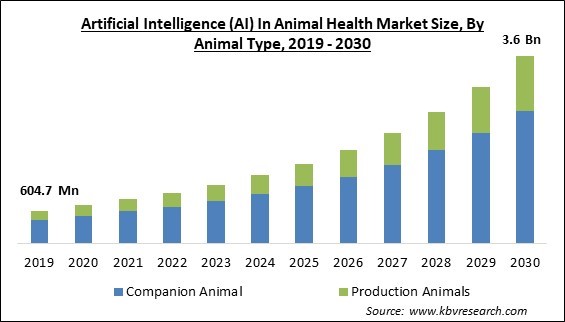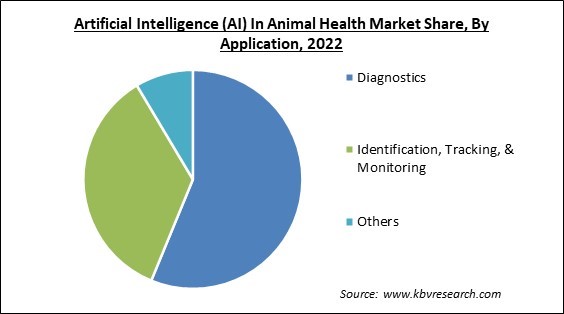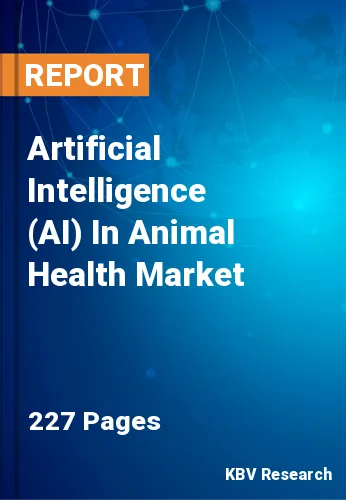The Global Artificial Intelligence (AI) In Animal Health Market size is expected to reach $3.6 billion by 2030, rising at a market growth of 18.1% CAGR during the forecast period.
Pet ownership is increasing worldwide, especially among millennial households, which usually have smaller families and have children later in life. Therefore, Companion Animal segment generated $2,513.3 million revenue in the market in 2022. The benefits of pet ownership for people's health include better heart health, fewer levels of depression and anxiety, and more. Pet ownership is increasing in emerging economies due to the growing middle class. Additionally, due to improved nutrition and medical treatment, pets live longer. Due to their higher propensity for illness, senior pets are becoming increasingly prevalent and require specialized care. Some of the factors impacting the market are AI-driven therapeutics advancements, Adoption of enhanced precision and predictive analytics, and resistance to technological change and ethical and legal issues.

AI advances greatly aid the advancement of precision medicine and targeted animal therapies. This has also encouraged the deployment of more efficient treatments in recent years. The market revenue is anticipated to expand due to the effectiveness and capacity to provide more precise indications of potential outbreaks of diseases and illnesses in animals and livestock in a rising number of nations. Additionally, supportive government programs, investments in AI research and development (R&D), collaborations between tech firms and veterinary institutions, and other factors encourage innovation and favorably impact the market's growth. The potential for further integrating AI into veterinary clinics is immense. Adopting AI-driven diagnostic tools, telemedicine platforms, and decision support systems is anticipated to boost growth prospects for companies in the animal health industry. Companies that provide AI-driven insights, extensive data analysis, and predictive analytics services to veterinary research institutes and organizations will profit from the growing need for AI-powered data analytics and research tools in the animal health sector. The adoption of AI in animal health around the globe is expected to propel market growth.
However, Artificial intelligence applications in animal health have increased moral and legal issues related to data privacy, consent, and animal welfare. Due to their inferior social, moral, and legal rights to humans, companion animals may be more vulnerable to AI's adverse effects than humans. These circumstances impact the morality of veterinary AI. At the same time, medical AI brings unique ethical concerns; concerns consist of algorithmic trust and transparency. These ethical and regulatory concerns may hinder the development of artificial intelligence (AI) in animal health market.
By animal type, the market is bifurcated into companion animals and production animals. In 2022, the companion animals segment registered the highest revenue share in the market. The need for cutting-edge healthcare solutions, such as AI-based diagnostics and individualized treatment plans, is driven by the growing trend of pet ownership and the growing emotional link between pet owners and their companion animals. The adoption of AI-based solutions to improve the quality of care and treatment results is also influenced by the availability of pet insurance and rising healthcare spending on companion animals.
Based on solutions, the market is segmented into hardware and software & services. The software and services segment acquired a substantial revenue share in the market in 2022. The segment's rise is fueled by ongoing improvements in software technologies, including sensors, imaging equipment, computer vision, deep learning, and wearables. These solutions are growing more affordable and accessible for animal owners owing to improvements in performance, miniaturization, power consumption, and cost. The market's expansion is also linked to collaborations between software developers, technological firms, veterinary clinics, universities, and trade groups. These collaborations have produced ground-breaking AI products designed exclusively for animal health applications.

On the basis of application, the market is fragmented into diagnostics, identification, tracking, & monitoring, and others. In 2022, the diagnostics segment held the highest revenue share in the market. Increasing AI integration in veterinary diagnostics, the availability of AI-powered diagnostic solutions, and the need to enhance diagnostic capabilities in animal health are factors influencing this rise. The musculoskeletal system is increasingly being addressed using veterinary diagnostic imaging. The growing adoption of veterinary diagnostic imaging contributes to the expansion of AI in animal health.
| Report Attribute | Details |
|---|---|
| Market size value in 2022 | USD 962.9 Million |
| Market size forecast in 2030 | USD 3.6 Billion |
| Base Year | 2022 |
| Historical Period | 2019 to 2021 |
| Forecast Period | 2023 to 2030 |
| Revenue Growth Rate | CAGR of 18.1% from 2023 to 2030 |
| Number of Pages | 227 |
| Number of Table | 330 |
| Report coverage | Market Trends, Revenue Estimation and Forecast, Segmentation Analysis, Regional and Country Breakdown, Companies Strategic Developments, Company Profiling |
| Segments covered | Animal type, Solutions, Application, Region |
| Country scope | US, Canada, Mexico, Germany, UK, France, Russia, Spain, Italy, China, Japan, India, South Korea, Singapore, Malaysia, Brazil, Argentina, UAE, Saudi Arabia, South Africa, Nigeria |
| Growth Drivers |
|
| Restraints |
|
Region-wise, the market is analyzed across North America, Europe, Asia Pacific, and LAMEA. In 2022, the North America region witnessed the largest revenue share in the market. Veterinarians may diagnose diseases and abnormalities with the help of AI algorithms that can examine radiographs, CT scans, and MRI images. The accuracy and speed of diagnosis are increased because these algorithms may identify patterns and signals that would be challenging for people to recognize. The U.S. and Canada's superior veterinary healthcare infrastructure and expanding use of AI in veterinary diagnostics are significant drivers of the regional share.
Free Valuable Insights: Global Artificial Intelligence (AI) In Animal Health Market size to reach USD 3.6 Billion by 2030
The market research report covers the analysis of key stake holders of the market. Key companies profiled in the report include Zoetis, Inc., Merck & Co., Inc., Heska Corporation (Antech Diagnostics, Inc), SignalPET, LLC, VetCT Specialists Limited, Veterinary Imaging Center of San Diego, Inc (Vetology), OneCup AI, Petriage, ImpriMed, Inc., and IDEXX Laboratories, Inc.
By Animal type
By Solutions
By Application
By Geography
The Market size is projected to reach USD 3.6 billion by 2030.
Adoption of enhanced precision and predictive analytics are driving the Market in coming years, however, Resistance to technological change and ethical and legal issues restraints the growth of the Market.
Zoetis, Inc., Merck & Co., Inc., Heska Corporation (Antech Diagnostics, Inc), SignalPET, LLC, VetCT Specialists Limited, Veterinary Imaging Center of San Diego, Inc (Vetology), OneCup AI, Petriage, ImpriMed, Inc., and IDEXX Laboratories, Inc.
The expected CAGR of this Market is 18.1% from 2023 to 2030.
The Hardware segment is leading the Market by Solutions in 2022; thereby, achieving a market value of $2.3 billion by 2030.
The North America region dominated the Market by Region in 2022, and would continue to be a dominant market till 2030; thereby, achieving a market value of $1.3 billion by 2030.
Our team of dedicated experts can provide you with attractive expansion opportunities for your business.

